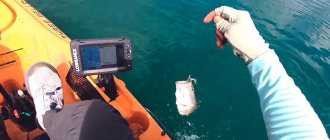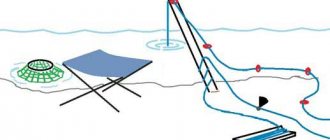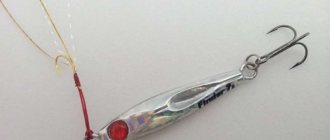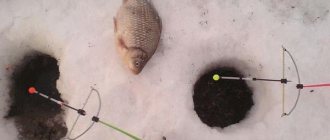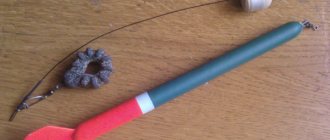Some species of fish look for food on the surface of the water or in its middle layers. From above you can catch perch, bleak, silver carp and chub. To catch other species of fish, mostly peaceful ones, you have to go to the bottom, since they find food for themselves without rising to the surface. Donka with an elastic band is one of the most promising and reliable methods of catching such fish. The rubber shock absorber helps to cast the tackle more accurately, creates less noise from casting and allows you to place several hooks (up to 10 pieces).
What is a rubber shock absorber and where is it used?
Content
Rubber shock absorbers appeared back in the 90s, but then they were made from pharmaceutical rubber bands. They were cut into strips and attached to a fishing line. There were more professional options, but they all quickly broke down. In addition to the need to constantly mount the elastic, the loss of the weight was also a problem.
The main purpose of a rubber shock absorber for fishing is to facilitate casting into the same area, as well as reduce noise levels. It was difficult for other bottom gear to get into the baited area. Rubber shock absorbers allow you to accurately throw the bait to a specific point in the reservoir.
The latest modification of such a donkey is a rubber shock absorber with a safety line attached to the sinker and the main line (in case of a break, it prevents the loss of the sinker), as well as an additional line, which is tied to the buoy. The role of the buoy is to monitor the location of the cargo, and additionally protects against falling into an undesirable place. Now the tackle is quite compact and brings a good catch.
The rubber shock absorber for the fishing rod is intended for catching deep-sea fish in still water; as an alternative, lane fishing is used in fast rivers.
Bottom tackle with a rubber shock absorber is designed for fishing from the shore and differs from other bottom tackles by the presence of a rubber insert between the main line and sinker
When compared with a drop bottom, a rubber shock absorber demonstrates a number of advantages:
- the tackle is suitable for both experienced fishermen and beginners;
- helps to get exactly to the baited place. The most effective bait mixtures: ready-made with the addition of clay, in PVA packages (they dissolve after a short exposure to water), paper;
- The bait can be thrown in with minimal noise. The donka silently sinks into the water, without scaring off peaceful, shy fish species;
- There are many hooks attached to the tackle, sometimes up to 10 pieces. The quantity directly depends on the casting distance and the type of reservoir. Hooks are placed along the entire line to prevent tangling;
- It is convenient to use soft bait mixtures, which often fall off the hook or can be damaged. Live bait, dough, bloodworms and chatterbait are often used.
Read more
How to catch ide in the spring?
Donka with a rubber shock absorber also has disadvantages:
- low mobility - it will take a lot of effort to change the fishing location;
- short service life of the rubber band on the fishing rod;
- frequent breaks of the ends of the shock absorber lead to the need to always have spare equipment and spend time collecting it while fishing;
- the angler may be injured when the gear breaks.
When using a fishing rod with a cast, only 1 shock absorber with 5 hooks is installed on the fishing rod per 1 angler.
Rubber shock absorber on float rod
Most sports fishermen are, of course, familiar with equipping a float rod with a rubber shock absorber and the features of its use. For those fishermen who are not yet familiar with this device, we will try to explain what it is.
A rubber shock absorber is an element of the equipment of a plug rod, although it is also successfully used on fly rods. It allows the angler to more effectively hook and then land fish, especially when using very thin, delicate equipment, although its main area of application is catching large fish. That is why the success of the upcoming fishing in most cases depends on the correct use of a rubber shock absorber.
The described structure is located in the so-called whale (the upper part of the plug rod) and, as a rule, is attached between the first and third knees, in exceptional cases - in the fourth or fifth section of the whale. The shock absorber installation diagram looks quite simple. It consists of the following elements: connector, Teflon tip, piece of rubber, locking cone.
The main working element, which bears the entire load, is rubber, which can stretch, as a rule, several times, on average up to five. At the same time, during the stretching process, the counterforce increases. The main indicator of rubber is its free diameter, usually from 0.5 to 2.5 mm, although there are thicker materials for fairly large fish.
The diameter of the rubber used directly depends on the size of the fish you plan to catch. For example, for fish weighing from 30 to 100 g, rubber with a diameter of 0.5-0.7 mm is quite suitable, from 100 to 250 g - 0.8-0.9 mm, up to 500 g - 1.0-1.2 mm, greater weight respectively - 1.4-1.6 mm and above. An incorrectly selected diameter can lead to the following consequences: if it is underestimated, the shock absorber may be significantly stretched, which gives the fish excessive freedom of action, will cause you problems and will take more time when fishing it. When using rubber of an unreasonably large diameter, in turn, the number of derailments will immediately increase due to the lack of necessary shock absorption, and the likelihood of the driver breaking will also increase. So an experienced fisherman knows that if these signs are present, the first thing to do is replace the whale being used with another one with an appropriate shock absorber. Although there are situations when fishermen deliberately install a shock absorber with a number one or two units higher than the optimal shock absorber. This is necessary in cases where you need to increase the speed of fishing, mainly in competitions.
The size of the shock absorber, which is used when fishing for roach weighing from 100 to 500 g, in my opinion, ranges from 0.8 to 1.0 mm. If during fishing the weight of the fish you catch increases, then it is worth increasing the size of the shock absorber by 1-2 numbers. In this case, there is no need to re-equip the rod, you just need to replace the kit. When installing a shock absorber, you should also know that its length depends on the rubber number. For example, a shock absorber with a diameter of 0.5-0.7 mm can be installed in the first elbow, 0.8-1.0 mm in the second, respectively, large numbers are installed in the third and even fourth elbow. The installation location may also depend on the length of the knees of the kit in which you are installing the shock absorber.
The next element of the equipment is the so-called cone, which has a variety of shapes: from hollow cone-shaped structures to semi-hollow reels on which unused rubber stock is wound. In my opinion, the main indicator of the quality of a cone is its working surface, with which it directly rests against the walls of the knee and serves
support for the shock absorber, as well as ease of use. One of the successful designs, for example, may be a cone from Stonfo. Trabucco's reel-style cone is also noteworthy due to its ease of use. Although this cone is not recommended when catching fairly large fish due to the small area of contact with the surface of the knee, since due to uneven pressure on the walls it can sink to the tip of the rod.
Cones come in different diameters and for different rods. Some have the ability to change the diameter, while others have it constant, then the cone needs to be cut to the required size (diameter).
Another element of the shock absorber is the so-called Teflon bushing, which is placed on the tip of the rod. Its main task is to protect the rubber from contact with the sharp parts of the tip and ensure that the rubber glides as smoothly as possible. The size of the bushing is slightly larger than the diameter of the rubber and is selected so that the rubber can move freely in the hole of the bushing. The outer part of the sleeve works in constant contact with the last element of our equipment - the connector.
Connectors from all manufacturers have basically a standard shape. The size of the connector must correspond to the diameter of the rubber, and most importantly, the size of the bushing with which it is in direct contact. He should not get stuck in it, much less fail. All connectors are generally brightly colored, which, when fishing for fish, will help you determine the degree of stretch of the shock absorber, the color of which contrasts with the color of the connector.
The critical point of the connector, and perhaps the entire equipment, is the point of contact between the rubber and the connector, or more precisely, with its clamping ring. With constant contact under a sufficiently large load, the rubber in this place wears out over time. Therefore, after each fishing, it is necessary to check the surface of the rubber in this place and if microcracks appear on it, this section of the shock absorber should be removed, the connector should be bandaged, and most importantly, the tension of the rubber should be adjusted again.
After a certain number of such operations, the supply of rubber will be exhausted, which means it will have to be replaced with a new one. The service life of a shock absorber directly depends on the intensity of use, sometimes it is even enough for more than one season, although many athletes, regardless of the condition of the rubber, still change it after winter, which is completely justified.
Another important detail of the equipment is lubricant for shock absorbers. This
the product is used almost constantly, which improves the sliding of rubber, its wear resistance and performance when in contact with water, which helps extend the life of the rubber shock absorber. Almost all manufacturers offer such a lubricant; it is relatively inexpensive, lasts a long time, and most importantly, it is quite effective, which affects the success of fishing as a whole.
In the process of installing the shock absorber, you will need, in addition to the basic equipment, the following tools and materials: scissors, a diamond file, a cable for pulling rubber and glue.
First, we determine the place on the tip of the rod where the Teflon tip will be installed. To do this, it is better to use a caliper, although many people do this by eye. Having determined the right place, we cut off the tip of the rod with a file and process the end, chamfering it.
When seating, the bushing should be put on with little effort. After making sure that the sleeve fits tightly, glue it to the tip of the rod. Using a metal cable, we pass the rubber through the tip.
We thread the end of the rubber into the blocking ring, and then tie the connector itself with a simple knot. Moreover
It is advisable to moisten the knot and tighten it with some force. We cut off the free end of the rubber, leaving about 2 mm, then secure the entire assembly with a clamping ring.
We insert the tip of the rod into the second elbow and measure the length of the rubber to the place where the stopper will be located, that is, we perform one of the most important operations - we adjust the tension of the shock absorber. If the connection between the second and third knees is telescopic, then the stopper can be located almost at the very edge of the knee, but if
Since this is a plug connection, the stopper should be recessed by 15-20 cm to ensure the desired fit of the sections.
We assemble the kit (in this case 2 sections), adjust the shock absorber tension. If a cone-type stopper is used, then adjustment is made by changing the diameter of the sleeve: you simply unscrew it or
twist it. If this is not enough, then you have a supply of rubber with which you can adjust the tension.
When using a stopper in the form of a reel, everything is much simpler: the tension is adjusted by winding or, conversely, unwinding the rubber from the cone. The degree of tension is determined
experimentally: the shock absorber should not be in a loose state, much less hanging from the tip of the rod. True, the tension should be insignificant for the shock absorber to work when playing even a small fish. This can be checked by hanging it from
a twenty-gram depth gauge is attached to the connector, which should show that even with such a small load the shock absorber will start working.
Once you learn how to adjust the tension of thin rubber shock absorbers, you can easily install larger shock absorbers. I will show this using the example of the process of installing a shock absorber with rubber with a diameter of 0.9 mm into the second elbow of a three-section telescopic kit. Pre-tensioning is also necessary to ensure that the shock absorber, especially when wet, retracts into the tip of the whale even after severe stretching and loading. You can also adjust the tension by reducing the length of the shock absorber. Let's say, if the length of the rubber in the free state is equal to the length of two sections of the whale in which we installed the shock absorber, then from the side of the cone we measure 10-15 cm and make a mark on the rubber, then at this mark we tie the cone. After experimenting a little, in the future you will be able to determine for yourself at what distance to make this mark in order to achieve the desired degree of shock absorber tension.
In order to be able to remove the stopper from the knee, a piece of fishing line with a diameter of 0.5-0.6 mm is tied to the opposite eye of the cone, then if it accidentally gets between the joints it will minimally deform the walls of the sections. Some anglers prefer to use nylon thread for this.
Now all that remains is to tie the rubber (preferably wetted) to the eye in the cone; you can repeat the knot for secure fastening. We leave the end of the rubber 20-30 cm long free, which will serve as a reserve in the future.
The described shock absorber mounting scheme can be used with the same success on a fly rod, where the cone can be inserted into the first, second and third bends. Some fishermen even manage, without using a cone, to use a rod plug, to which a fairly thick fishing line is attached, stretched inside the rod. It is to this that a shock absorber of the required length is attached via a swivel. Thus, the entire load falls on the plug, which is especially important when catching large fish, while the rod itself does not experience the load, but serves only as a carrier of this equipment, like, say, a Bolognese rod.
Now that you have equipped your rod with a shock absorber, get to the pond quickly! And there you will see that the thrill with which the rubber shock absorber will react to the twitching of the fish on the hook of your fishing rod will compensate for the time spent on installing the equipment.
Author:
V. Unichenko
How to make a donk with a rubber shock absorber?
A donka with a shock-absorbing damper is a simple piece of equipment, it is easy to use and easy to make yourself.
As a rubber insert, rubber bands for fishing and household purposes are usually used - round or square. Do-it
-yourself donk rubber is made from:
- fishing line with a cross section of 0.2 mm or more (can be replaced with braid). It is wound on a prepared reel; moderate tension should be created. Rings for elastic bands and leashes are attached to the main line, or figure-of-eight loops and loops for other parts of the equipment are made. The location should prevent the gear from getting tangled with each other during retrieval to the feeding area. To prevent the hooks from getting caught, cambrics are installed on the fishing line;
- bottom fishing rod with a rubber shock absorber - a rubber strip with a round cross-section (square blanks are allowed) and a diameter of about 3 mm. Round elastic bands for shock absorbers are intended for peaceful fish, square ones for predatory ones. An easy way to obtain it is to buy the required length in the store; it is sold in prepared sizes of 5, 10, 15, 20 m. The length of the shock absorber is selected taking into account the casting distance. Loops are knitted along the edges of the elastic band, and swivels with fasteners are attached to them;
- lead sinker;
- fishing line, a leash is made from it;
- hooks are selected taking into account the expected load. When making a donkey with an elastic band, the choice of hooks is important, but it directly depends on the size of the bait and its color;
- The buoy and weight cord will help determine the casting location; they are made of material that floats above the water level. The main thing is to ensure the visibility of the buoy from afar. The element is used when it is possible to place the load on the craft in advance. A cord with a weight is attached to the foam (it is better to paint it in a bright color). The length of the fishing line depends on the depth of the reservoir;
- reel, 2 pcs., simplifies transportation;
- bite alarm. An object that indicates the presence of vibrations in the fishing line is suitable: bells, bells, electronic options, etc.
Read more
How to catch catfish on a donkey from the shore?
There is a fairly simple relationship: the shorter the shock absorber, the less it will stretch and absorb the jerks of the fish less, that is, it will actually be stiffer
Where is a rubber shock absorber used?
3.1 Rubber shock absorber in feeder installations
The rubber shock absorber for the feeder is a piece of elastic designed for bottom equipment. When fishing with a feeder, shock-absorbing rubber bands are used, invented by the British “power gum” or “feeder gum”, which will be discussed in the following articles.
3.1.1 Why is a shock absorber installed in feeder installations?
Not missing a bite is one of the important points in feeder fishing, which is sometimes problematic, since feeder rigs use heavy feeders (rough equipment), which affects sensitivity. In order to catch the most delicate bite, you need to equip your fishing rod with sensitive equipment, which is achieved by installing a feeder elastic band.
2.1.3 Alternative to feeder rubber
Many anglers use plug rubber for their feeder rigs due to its elasticity and wide range of sizes.
If you don’t have such rubber bands in your arsenal, then you can use a multi-strand harness as a shock absorber, the main thing is to choose the right diameter.
But the feeder shock absorber from beaded elastic is made by fisherman A. Parovozov with his own hands
Rubber gloves can also be useful for making a shock absorber for a feeder, and see how to make one from this material on the “Wild Locksmith” channel
3.1.4 Features of installing a rubber shock absorber in a feeder installation
The diameter of the rubber shock absorber must correspond not only to the size of the fishing line, but also to the fishing conditions. For example, as the flow speed increases, the diameter of the shock absorber also increases.
How can you tell if the shock absorber section is selected correctly? In operation, that is (being at the bottom), your equipment should look as shown in this photo, that is, with a free distance of 2-3 cm between the tube and the cambric
To prevent the shock absorber from stretching in the feeder, it is fixed to the fishing line with a silicone stopper using a cambric.
How to check if the rubber band is working correctly? You need to conduct a test at the fishing site, read more about it here https://fishinginrus.ru/stati/rybalka-na-rusi/teoriya-i-praktika/680
One of the simple options for installing a feeder elastic from fisherman Sergei Markov, read here https://www.matchfishing.ru/fishing/articles/det1172811/
3.1.5 How to hook fish if a shock absorber is installed?
The hook must be smooth and sweeping, since the rubber shock absorber must first be stretched and then hook the prey.
3.2. How to install a rubber shock absorber on a fly rod
One of the methods of attaching an elastic band to the swing will be demonstrated by the Barnaul Fishing channel.
Equipping a fly rod is also possible in the following way:
- We shorten the stock (knee) of the fishing rod so that a hole opens through which the existing shock-absorbing elastic band can be pulled. If you feel sorry for a new rod, then in specialized stores you can buy a special whip and do everything on it.
- Attach a sleeve to the tip of the whip (can be secured with glue), along which the elastic band will slide.
- As a rule, the shock absorber is attached at the beginning of the 2nd or at the end of the 3rd warehouse of the fly rod using a collet plug or reel cone.
- The line is connected to the shock absorber through a connector. Moreover, the main thread should be half a meter shorter than the length of the tackle, this will help in managing the tackle.
For clarity of the mounting diagram, see the photo.
And here are the elements used:
- “A” - cone with reel;
- “B” - collet cone;
- “B” - Teflon bushing;
- "G" - connector.
Advice:
- use an elastic band with a diameter of 1 to 1.8 mm (the diameter directly depends on the size of the fish);
- the length of the elastic depends on where you started to attach it (2nd, 3rd leg of the fishing rod), but should not be less than 1.5 m;
- for fishing with this type of equipment, purchase a landing net with a long handle, since the shock absorber stretches strongly, which increases the distance to the fish;
- The elastic band tends to quickly become unusable, for this it needs to be inspected, especially in the area of \u200b\u200bthe connection with the connector.
Here, amateur fisherman Vladimir describes and schematically shows his invention (attachment of an elastic shock absorber), which he came up with in order to use a fly rod with an elastic band for fishing in wild, overgrown places. Also on the forum you will read the opinions of other reputable fishermen https://fishing-ua.com/threads/13151/
Alexander Stalyarov in his video will demonstrate how he uses a fly rod to catch carp on a rubber shock absorber
3.3 Rubber shock absorber in plug
A rubber shock absorber is an essential part of a plug fishing rod, located inside one, two or three upper knees of the fishing rod, that is, when a small piece of rubber is attached with one end to a stopper installed inside the knee, and the other to the connector (clasp). All accessories are attached to the connector.
3.3.1 Material of rubber shock absorbers for plug
The rubber used in the plug is made of latex or elastic. The latex shock absorber has a solid cross-section of 0.5 - 2.5 mm in diameter. This variety in the diameter of the elastic allows the fisherman to choose a shock absorber for specific fishing conditions.
Such shock absorber material as elastic is represented by a more limited number of diameters:
- 1;
- 1,6;
- 1,8;
- 2,1;
- 3 mm.
Elastic is inferior to latex; a diameter of 3.0 mm can be used for catching carp weighing no more than 3 kg. The advantage of elastic over latex is noticed in winter, since it does not freeze.
3.3.2 How to choose the right diameter for the rubber shock absorber in the plug
In order to make the right choice regarding a latex shock absorber, you should consider several rules:
- A shock absorber with a diameter of 0.7 mm is installed in two plug elbows. It has proven itself well in catching small fish (roach, bleak, gudgeon, dace) and in winter fishing. This diameter is perfect for catching fish up to 300 g. It goes well with fishing leashes of 0.06 or 0.07 mm, small fishing hooks. The disadvantage is that it wears out quickly; it is necessary to periodically bandage the connector, removing areas that have become unusable. In winter, the shock absorber in the plug shell freezes.
- A shock absorber with a diameter of 0.8 mm is considered universal and is installed in two or three elbows. Advantage - allows you to catch fish up to 1 kg, catches delicate bites, can be used many times, fits well with equipment up to 5 g, leashes with a diameter of 0.08 or 0.09 mm.
- A shock absorber with a diameter of 0.9 mm is installed on three elbows. It has proven itself well when catching small roach and large bream at different current speeds. Compatible with rigs from 8 to 10 g, 8 gram flat floats and leaders up to 0.12 mm. Disadvantage - you need to monitor the condition and bandage it during the fishing season.
- A shock absorber with a diameter of 1.0 mm is thick rubber, designed for catching fish from 300 g. Does not work well with thin equipment. For fishing with this diameter in strong currents, you can install a float weighing up to 12 g. The advantage is wear resistance, as a rule, it can withstand one fishing season.
- A shock absorber with a diameter of 1.2 to 1.6 mm is used for catching a specific trophy (large bream, perch, chub) in a high-speed current and is used with flat floats.
- A shock absorber with a diameter of 1.8 to 2.5 mm - this type of elastic is used in carp fishing, but it is advisable not to install a diameter exceeding 1.8 mm on a match plug rod.
In addition to the variety in diameter, the rubber shock absorber for the plug is distinguished by its elasticity, for example, the elastic band under No. 1 is thin and soft, but under No. 20 it is the most elastic. The thin shock absorber stretches strongly, which is noticeable even when catching small fish; for a beginner, the fishing process becomes difficult to control and difficult. The use of a large diameter negatively affects the sensitivity of the bite and causes the prey to disappear.
To help you make the right choice regarding the shock absorber you need, use this example table:
- No. 2 - for fish weighing from 50 to 100 g;
- No. 3-4 for fish weighing from 100 to 200 g;
- No. 5 for fish weighing up to 500 g;
- No. 6 for fish weighing up to 1.5 kg;
- No. 8 and 10 large, powerful, trophy fish.
In order for the rubber shock absorber to be effective, it is installed on certain knees of the tackle:
- No. 1 (0.5 mm) – 1 elbow;
- No. 2 (0.65 mm) - 1;
- No. 3 (0.75 mm) – 1 or 2;
- No. 4 (0.85 mm) – 2;
- No. 5 (0.95 mm) – 2;
- No. 6 (1.05 mm) – 2 or 3;
- No. 8 (1.25 mm) – 3;
- No. 10 (1.45 mm) – 3;
- No. 12 (1.60 mm) – 3;
- No. 14 (1.80 mm) – 3;
- No. 16 (2.0 mm) – 3 or 4.
An important element when installing the elastic is the bushing, which serves as protection (from contact with the sharp edges of the whip) and ensures free sliding. When choosing rubber, you need to take into account the diameter of this element. The rubber shock absorber should fit freely into its hole.
3.3.3 How to install the shock absorber on the plug
Andrey Kavchinsky will talk about this in detail in his video instructions.
3.4 Rubber shock absorber in float equipment
The use of a shock absorber in float gear, as well as in fishing with a plug, allows you to more effectively hook and fish out prey even when using the most delicate equipment.
The diameter of the rubber is selected according to the weight of the fish, see the table above.
3.4.1 Making a rubber shock absorber for float fishing
In his video, S. Maksimenko will tell you in detail how to make and secure a shock absorber for a float rod yourself
How to tie a fishing line with an elastic band correctly?
The most important condition for quality tackle is good and strong knots. The shock absorber rubber bands are attached using very simple, but durable and strong units. One of the best tying techniques is the clinch. Taking into account the choice of technique for preparing loops for leashes, the method of their installation differs. A simple technique - “loop to loop” - involves creating loops on the main fishing line. On the opposite side of the leash, make a standard loop or figure eight.
You can improve the method by attaching a swivel clasp to the free edge. If the fishing rubber for the donkey breaks or the leash gets damaged, the fisherman will be able to replace the element of the tackle much faster. It will also speed up the disassembly process after fishing is completed.
How to tie a garland with leashes
Separately, we knit an insert with leashes and hooks - a garland. To do this, we need a piece of fishing line, two carabiners, buttons, beads and pieces of cambric. First we tie the carabiner. Then we put on the cambric, then the bead.
We move the bead to a distance of 50 centimeters from the carabiner and pass the end of the fishing line through it again from the side of the attached carabiner. Then we put a button on the fishing line through one hole and put the bead back on. We attach the leash to the second hole of the button using the “loop-to-loop” method. The result is a connection in which the leash rotates freely along the main line using the “helicopter” type of installation.
Helicopter with leash
We do the same every 70-100 centimeters. The number of leashes depends on the greed of the fisherman and fishing conditions. Some people make a garland with four hooks, others with ten.
The initial section of the garland
You can attach as many of these rigs at home as you like and store them on reels. At the same time, we insert hooks into the cambrics to protect them and from them.
Garland on a reel
Selection of weights and leashes
During the manufacture of the leash, high-strength versions of thin fishing line (about 0.14–0.2 mm) are used. The length is set at your own discretion, but in standing water it is better to make it 10–20 cm, and in rivers with a current, the length of the leash is 30–40 cm. A hook is attached to the leash at one end, and a swivel is installed at the opposite end, on which a fastener is attached or knitted loop.
Thanks to the weight of the sinker, contact with the bottom of the reservoir is ensured. There are no restrictions on the shape, but many anglers prefer a flat weight, as it does not roll along the bottom in rivers with small currents. If the bottom is covered with a large layer of silt, it is better to use weights in the form of drops or balls. An alternative is to use a bag of stones, but this creates more noise.
Donks with elastic bands use relatively heavy weights
A separate piece of fishing line (about 30 cm) is made for the load, and a fastening loop with a shock absorber is mounted on the edge. The structure of the donkey with an elastic band may differ slightly, but it is impossible to attach the load to the main fishing line in all modifications.
The leader shock absorber will last longer with a lighter weight, so there is no need for too much lead. In any case, it is better to buy elastic for the donk with a reserve; if the tackle breaks during casting, it can be quickly restored.
Fishing technique
Fishing with a donk should not cause any particular difficulties. The fishing process itself differs little from ordinary donkey.
Despite the pre-selected shock absorber, when fishing you often have to adapt to real conditions
Fishing with a donk with a rubber shock absorber is carried out according to the following scheme:
- Installation of the buoy. You need to bring an improvised buoy to an area favored by fish: depressions, holes at the bottom, a quiet bay.
- Feeding the area. All bait is suitable, including soft bait or with a water-soluble coating.
- Throwing tackle. Beginner fishermen ask how to throw a rubber band at the bottom, but in reality there is nothing complicated, the tackle just looks oversized. The most difficult is the first cast, introducing the load. It is important to keep the line tension at the time of casting and remove objects that could interfere with the movement of the line so that the hooks do not get tangled.
- Waiting for a bite. Fishing with a rubber shock absorber comes down to waiting - when a fish bites the hook, the bite alarm will report this.
Tips and tricks
Basic principles of fishing:
- It’s better to throw the load right away. Repeated casts increase the risk of scaring away the fish; they may not return to their original place;
- The elastic band creates shock absorption when the fish jerks, so the supposed small fish may turn out to be a large specimen; you should be prepared for such a situation. The tackle is sensitive to bites from small fish;
- bait can be changed directly while suspended;
- It is better to make the reel from polished wood, this will prevent damage to the elastic band;
- when winding the elastic band on the reel, do not create strong tension;
- rubber is sensitive to the sun, the tackle should be stored in a place protected from rays, otherwise the material will lose its elasticity;
- during the fishing process, fold the fishing line into rings with careful movements;
- It is convenient to equip a tackle holder on the shore to free both hands when changing hooks or bait.
The elastic increases fishing efficiency due to the silent casting and a large number of hooks. It is often possible to catch 2–3 small to medium-sized specimens at a time. Large specimens of crucian carp and pike are often caught with such a donkey.
Originally posted 2018-07-30 11:45:35.




